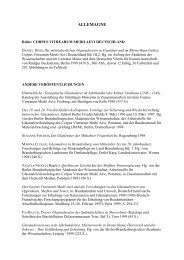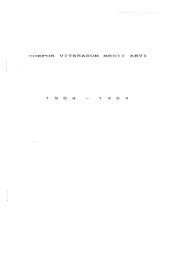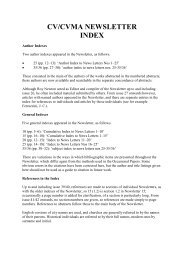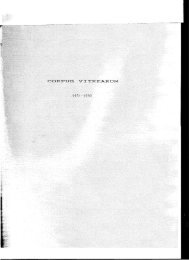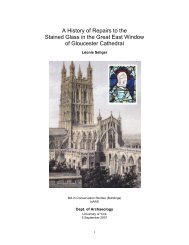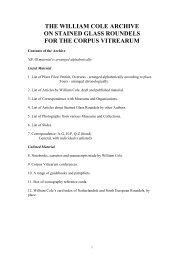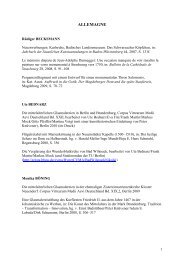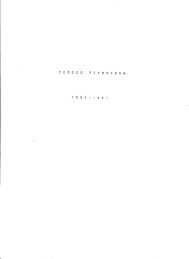BristolConference - Corpus Vitrearum Medii Aevi
BristolConference - Corpus Vitrearum Medii Aevi
BristolConference - Corpus Vitrearum Medii Aevi
You also want an ePaper? Increase the reach of your titles
YUMPU automatically turns print PDFs into web optimized ePapers that Google loves.
Fairford<br />
A church has existed here since before 1100.<br />
Except for the lower part of the central tower, it<br />
was completely rebuilt from the 1490s by the<br />
Tames, a family of wealthy clothiers. In 1542<br />
John Leland, a generally reliable witness, wrote<br />
'John Tame began the fair new chirch of<br />
Fairforde and Edmund Tame finishid it'.<br />
Neither John Tame's will, made in 1497, nor<br />
that of his son Edmund, made in 1534,<br />
mentions the fabric or the windows. However,<br />
John Tame's initiation of the project is borne out<br />
by his burial in a position normally reserved for<br />
a founder. It is probable that Edmund, who<br />
acquired both significant wealth and social<br />
status, embellished the new church with its<br />
remarkable set of stained glass windows in the<br />
early years of the 16 th century.<br />
Although built by wool merchants, the church<br />
does not share the most characteristic features of<br />
other late medieval 'wool churches' in the<br />
Cotswolds. The pier profile of the nave arcade<br />
has no parallels in the Cotswolds, but is similar<br />
to that of the University Church of St Mary the<br />
Virgin, Oxford, dating from the 1490s,<br />
suggesting that the rebuild was carried out<br />
by Oxford masons. There is a marked absence<br />
of sculptural ornamentation compared, for<br />
example, to the churches at Cirencester and<br />
Northleach. The clerestory windows are set<br />
wide apart, rather than being separated only by<br />
clustered shafts, as in the 'lantern' clerestories at<br />
Chipping Norton, Northleach and Cirencester.<br />
The window tracery at Fairford is not of the<br />
repetitive 'gridiron' type, but varies according<br />
to the location and importance of the window.<br />
Hence, in order of ascending complexity and<br />
importance, there are different designs for the<br />
clerestory,aisles, west wall and eastern chapels,<br />
and the chancel. The east window is of a design<br />
unique to the church, with quatrefoils in its<br />
tracery and pierced transom.<br />
The differentiation of window designs and the<br />
overall plainness of the intervening stonework<br />
is an indication of the importance accorded to<br />
the stained glass.<br />
THE STAINEDGLASS<br />
Fairford is unique among English medieval<br />
parish churches in retaining a complete set of<br />
medieval stained glass windows. Twenty-eight<br />
in all, they were installed in a single campaign<br />
in the early 16 th century.<br />
Style and Design. In style as well as iconography<br />
the glass is heavily indebted to continental<br />
sources. The composition of the Crucifixion<br />
scene, for example, derives from late 15 th _<br />
century Netherlandish altarpieces, while the<br />
pictorial treatment of the windows at the east<br />
end, with landscape settings and realistic<br />
interiors, owes its inspiration to the work of<br />
Van Eyck, Memling and their contemporaries.<br />
Date. The appointment in 1497 of Barnard<br />
Flower, a foreign glazier, as King's Glazier,<br />
heralded a transformation in English stained<br />
glass. Immigrant glaziers, mainly from the<br />
Low Countries, began to introduce new styles<br />
and techniques through the major glazing<br />
commissions that they won during the early<br />
16 th century. The Fairford glass was clearly<br />
executed by foreign glaziers and relates to<br />
schemes at Westminster Abbey and King's<br />
College, Cambridge.<br />
Hilary Wayment's dating of c.1500-17 has<br />
recently been modified by Richard Marks, who<br />
considers it unlikely that Fairford predates<br />
the comparable glazing of Henry VII's Chapel at<br />
Westminster(1509-1511). Marks,however, accepts<br />
a dating before c.1515, given the absence of<br />
Renaissance classicizing decorative motifs.<br />
Technique. The Fairford glass was produced by<br />
exceptionally skilled craftsmen, whose work<br />
includes virtuoso cutting, drilling and<br />
accomplished handling of inserts (see, for<br />
example, the eyes of the demons in the north<br />
clerestory windows). Flashed glasses (ruby,<br />
green and even red on blue in sII) are used<br />
extensively and subtly abraded (eg. the book<br />
lying on the ground in I). The 1987-2000<br />
conservation programme revealed the use (for<br />
the dragon in SIll) of a striated type of glass<br />
employed in Paris and Nuremburg in around<br />
1500 and usually reserved for vessel glass. It<br />
consists of white glass on to which white<br />
filaments of colour have been 'trailed'.<br />
Iconographic Programme. The iconographic<br />
programme is exceptionally coherent for a<br />
parish church. It comprises three elements: the<br />
Life of Christ; the Exponents of the Faith; and<br />
the Last Judgement.<br />
The east end of the church is devoted to the Life<br />
of Christ. The cycle accords prominence to the<br />
Virgin, to whom the church is dedicated, and<br />
begins with the typological window in the<br />
25



